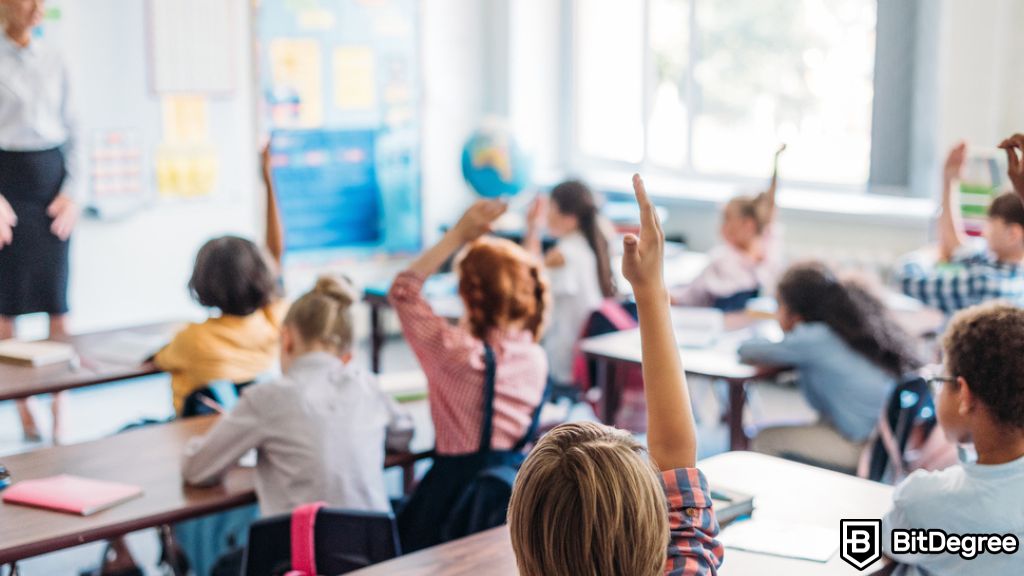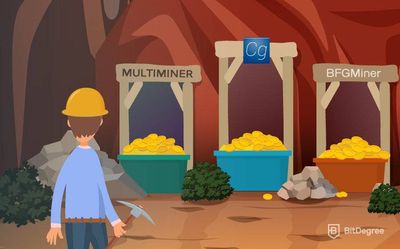Key Takeaways
- The integration of blockchain and education can help solve issues in traditional systems like academic fraud and vulnerable data security by providing immutable digital credentials, automated workflows, and enhanced transparency.
- Implementing blockchain education solutions benefit many stakeholders, from students to employers and the government.
- Amidst the benefits of blockchain education innovations, stakeholders should be aware of their challenges like high development and maintenance cost and environmental impact.
Free Airdrop Season 7 is LIVE! Answer fun questions or do simple tasks to earn rewards from the $30K BitDegree prize pool. Participate Now ! 🔥
Imagine a scenario where you have to prove the authenticity of your academic records to an employer, but traditional verification methods are slow and cumbersome. Enter a blockchain education solution that allows you to securely manage and authenticate academic credentials.
Blockchain technology offers a transformative approach to addressing the complexities and vulnerabilities in traditional academic systems, such as error-prone transcript verification and standardized learning experiences that lack personalization.
In this article, we'll delve into how blockchain education solutions revolutionize how the academic world works. As a sidenote, don't forget to check out top crypto exchanges (such as Binance or Coinbase) and wallets (i.e. Ledger) if you plan on starting a crypto-related journey of your own!

Did you know?
Subscribe - We publish new crypto explainer videos every week!
What is the Metaverse? (Meaning + Animated Examples)
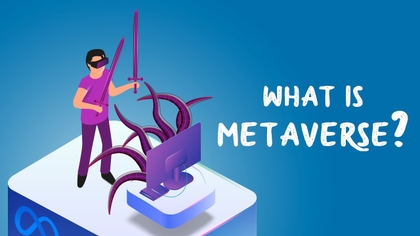

Table of Contents
- 1. Introduction to Blockchain
- 2. Current Challenges in Education
- 2.1. Academic Fraud
- 2.2. Vulnerable Data Security
- 2.3. Error-Prone Transcript Verification
- 2.4. Lack of Transparency in Credentialing
- 3. How Blockchain Education Solutions are Redefining the Academic World
- 3.1. Digital Credentials and Certificates
- 3.2. Secure Transcript Verification
- 3.3. Data Security and Privacy
- 3.4. Micro-Credentials
- 3.5. Personalized and Lifelong Learning
- 4. Benefits of Blockchain Education Projects for Stakeholders
- 4.1. Benefits for Students
- 4.2. Benefits for Educational Institutions
- 4.3. Benefits for Employers
- 4.4. Benefits for Government and Regulatory Bodies
- 5. Challenges and Considerations
- 5.1. Technical Complexity
- 5.2. Cost and Resource Allocation
- 5.3. Environmental Impact
- 6. Conclusions
Introduction to Blockchain
Blockchain is a revolutionary technology that creates a secure and transparent way to store and transfer data. It operates as a decentralized digital ledger, recording transactions across multiple computers so that the recorded information cannot be altered retroactively.
Latest Deal Active Right Now:Head to BitDegree Missions, gather as many Bits as possible & claim your stake of the $30,000 Prize Pool! Don't waste your time & start collecting Bits by completing Missions and referring friends.
When talking about blockchain tech, you’ll also get familiarized with smart contracts. They’re self-executing contracts with the terms directly written into code. These automatically enforce and execute agreements when conditions are met, reducing the need for intermediaries.

Many industries have applied blockchain technology in their operations for various purposes. The real estate sector, for example, uses blockchains to enhance transparency in ownership records, reduce fraud, and expand accessibility.
Current Challenges in Education
Before we jump into how blockchain education solutions offer innovative approaches to issues in the academic world, let’s take a closer look at some of the most common problems in this industry.
These issues not only impact the institutions themselves but also students, employers, and other stakeholders in the long run.
Academic Fraud
Academic fraud is a major challenge in the education sector, covering a range of dishonest practices that damage the integrity and credibility of academic institutions. These include:
- Plagiarism
- Cheating on exams or assignments
- Fabrication of research data
- Purchasing essays or assignments
- Production of fake degrees or certificates
In 2019, more than 15,000 teachers in Kwania participated in a process meant to verify their credentials and qualifications, but they presented fraudulent or counterfeit documents during this exercise.

This incident indicates a significant issue within the academic environment, especially when a group of teachers is involved. Technology has made it easier to create counterfeit academic documents, making it hard for employers and institutions to verify their authenticity.
The consequences of academic fraud are far-reaching and harmful. For students, engaging in academic fraud can threaten their future prospects and professional reputation. Fraudulent practices can also ruin educational institutions’ credibility, destroying trust among students, employers, and the wider community.
That's why it's important to have an innovative tool that counteracts this issue by providing verifiable academic records.
Vulnerable Data Security
Educational institutions hold huge amounts of sensitive personal and academic information, including student records, financial information, and research data.
Traditional data storage methods are often vulnerable to hacking, data breaches, or unauthorized access, risking the exposure of confidential information.
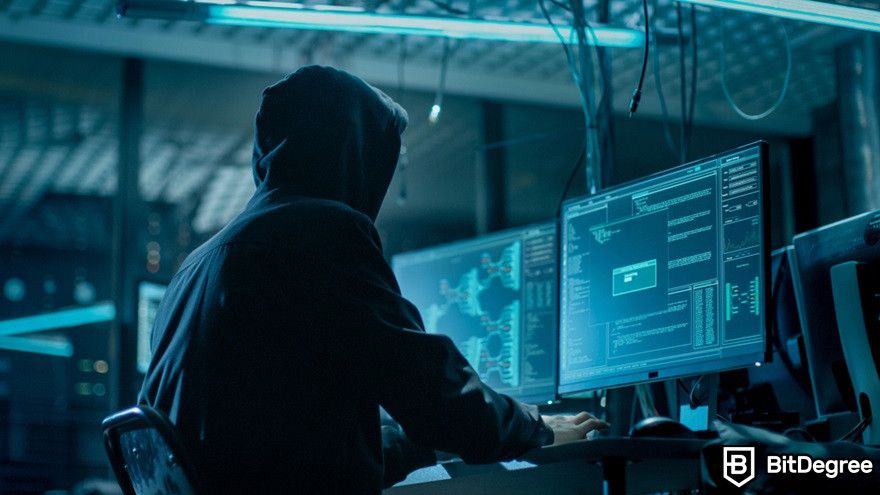
More importantly, cybercriminals are increasingly targeting schools and universities, seeking to exploit vulnerabilities in their systems. These threats include malware, phishing attacks, ransomware, and data breaches, which can result in the theft or unauthorized access of sensitive data.
Additionally, academic institutions often work with third-party vendors and service providers for various functions, such as student information systems, cloud storage, and online learning platforms. However, these partnerships potentially expose sensitive data to compromise.
In 2020, Verizon, a multinational telecommunications company in America, shared its Data Breach Investigations Report and revealed alarming statistics regarding the education sector.
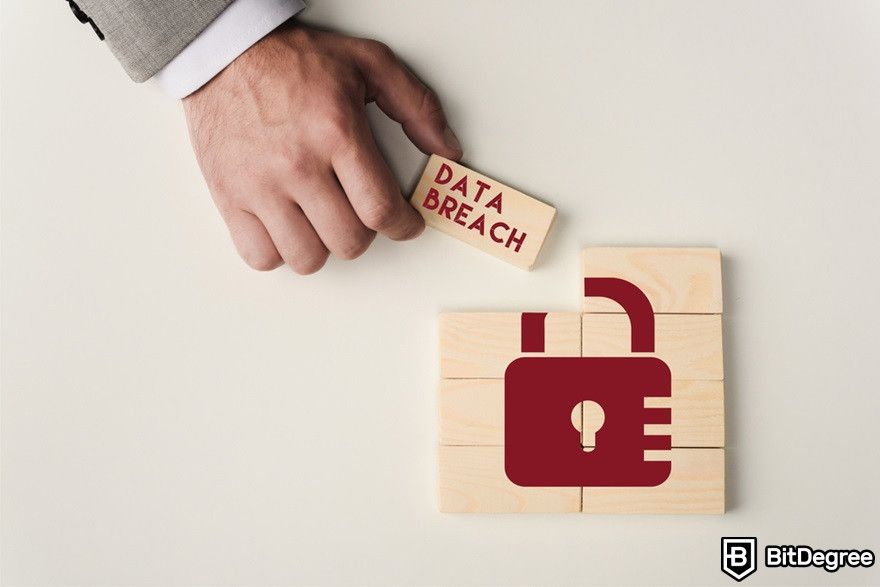
Among the 20 sectors examined, education was ranked sixth in the number of cybersecurity incidents, with an astounding 819 incidents reported that year.
Error-Prone Transcript Verification
Transcript verification is often a time-consuming and error-prone process. Institutions typically rely on manual checks and physical records, which can lead to delays and inefficiencies.
The reliance on manual processes also increases the risk of associated issues, such as:
- Human error. Manual labor can increase the likelihood of human errors, such as data entry mistakes, misfiling, and oversight.
- Counterfeit documents. Traditional verification methods often lack sophisticated tools to detect forged documents, making it challenging for institutions and employers to ensure that they only accept and recognize authentic academic records.
- Data inconsistencies. Students often attend multiple institutions throughout their academic careers, leading to fragmented records stored across different databases. Unfortunately, mistakes and differences might happen when these records are brought together for checking.
- Identity theft. When sensitive personal information, such as social security numbers, is shared for verification purposes, there's a risk of mishandling the documents. Unauthorized access to the information enables perpetrators to steal someone's identity, leading to financial fraud and other malicious activities.
- Resource intensive. Traditional transcript verification requires significant administrative resources, including dedicated staff and related infrastructure like filling cabinets, mail services, and printing equipment, which may lead to higher operational costs.
These mistakes can lead to incorrect verifications and potential disputes.

With the growing number of international students, the challenge of verifying foreign academic records becomes more difficult. The various educational systems, languages, and credential formats make the verification process more complex.
Lack of Transparency in Credentialing
Credentialing refers to the process of verifying and validating the qualifications, skills, and achievements of individuals. It involves the issuance and recognition of formal credentials, such as diplomas, degrees, certificates, and licenses.
The credentialing process ensures that individuals have met certain standards or criteria established by educational institutions or regulatory authorities. It plays a crucial role in facilitating employment, further education, and professional advancement.
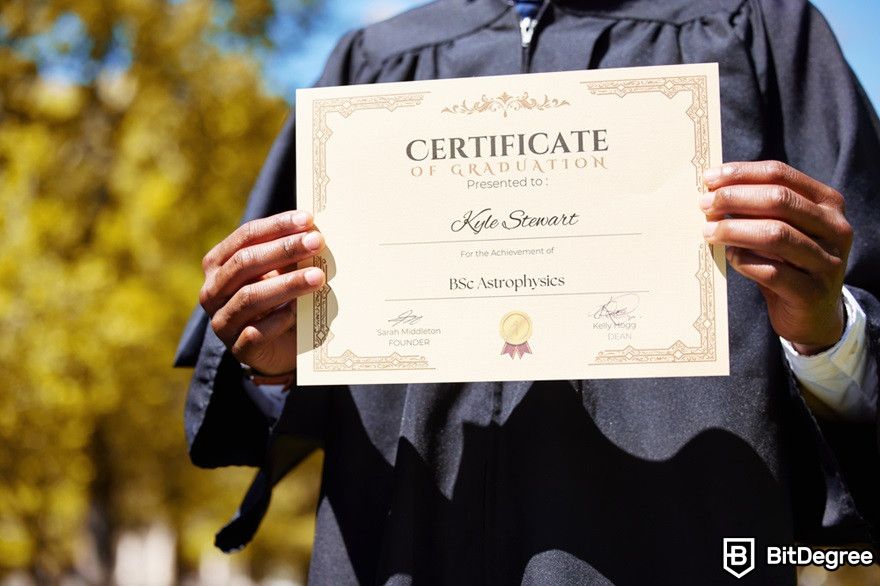
However, traditional education systems often make the credentialing process unclear, with limited insight into how academic accomplishments are documented and confirmed. This lack of transparency may result in discrepancies and inconsistencies in educational records.
Students and graduates may find it challenging to track their academic credentials or share them with employers and other institutions due to bureaucratic hurdles, including paperwork, administrative delays, and red tape.
These obstacles can hinder their career advancement and educational opportunities.
How Blockchain Education Solutions are Redefining the Academic World
Moving on from the challenges in education, we'll explore how blockchain education projects can be the answer to address longstanding issues and redefine traditional practices.
Let's see how the technology can build a more secure, efficient, and transparent educational experience!

Did you know?
Subscribe - We publish new crypto explainer videos every week!
How to Use Crypto? 5 Rewarding Strategies Explained (Animated)


Digital Credentials and Certificates
Traditional paper-based credentials are prone to loss and damage, making it challenging to verify the authenticity of academic records. This vulnerability may lead to academic fraud and a lack of transparency in credentialing.

A blockchain education solution comes with immutable digital credentials and certificates.
Each entry on the blockchain, such as the issuance or verification of a credential, is cryptographically secured and time-stamped, thanks to its cryptography techniques and decentralized nature.
No single entity will be able to alter the data without consensus from the network participants, ensuring the authenticity of academic records throughout their lifecycle.
The Massachusetts Institute of Technology (MIT) came up with a blockchain education solution to issue digital diplomas. It's developed in partnership with Learning Machine and coded using Blockcerts, an internationally recognized standard for securing essential digital records.
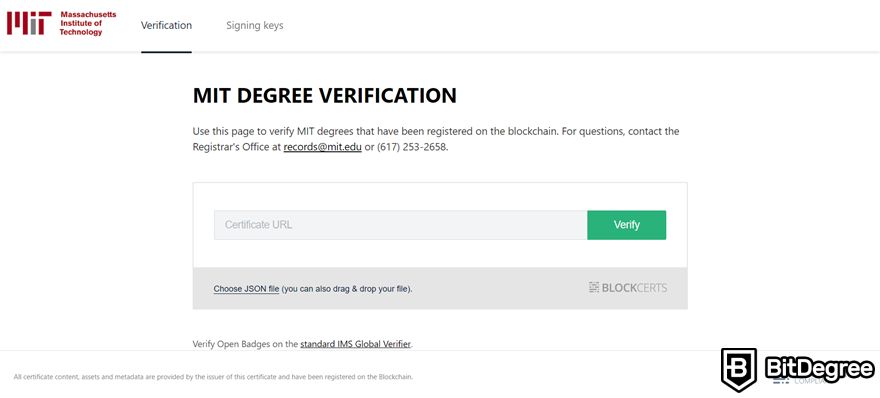
Graduates receive a digital version of their diploma, which they can easily share with employers or other institutions. These digital credentials can be quickly verified through a blockchain-based verification portal without the need for intermediaries.
Another example is APPII. It combines blockchain, smart contracts, and machine learning to check the academic credentials of potential students and professors.
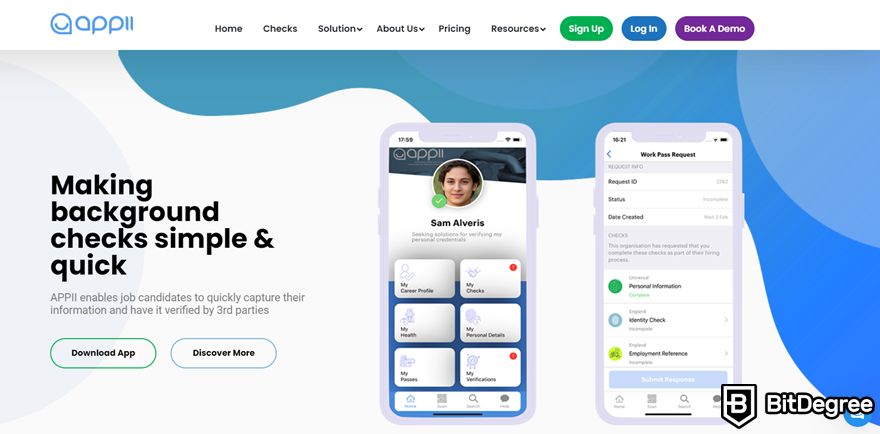
Users create a profile and fill out their CV, including education history and transcripts. Then, APPII employs blockchain to authenticate a user’s credentials and securely store their information within its blockchain network.
Secure Transcript Verification
Manual transcript verification can lead to delays and inconsistencies in academic record-keeping, hindering the efficiency of education. Blockchain technology enables quick verification of academic records through smart contracts.
Smart contracts eliminate time-consuming manual checks or third-party intermediaries. They automate the verification process by executing predefined logic to check academic credentials.
For example, smart contracts can compare the credentials presented by a candidate with the records stored on the blockchain. If the credentials match the records, the verification is deemed successful.
Employers and educational institutions can verify transcripts in real time, streamlining the verification process.

OpenCerts is an open-source blockchain education tool developed by GovTech Singapore in collaboration with several academic institutions and technology partners. It creates tamper-proof digital certificates and transcripts that can be easily verified by employers, educational institutions, and other relevant parties.
Data Security and Privacy
Traditional data storage systems are often vulnerable to breaches and unauthorized access. This is particularly concerning, considering that educational institutions hold a lot of sensitive data.
By implementing blockchain education solutions and Self-Sovereign Identity (SSI), these institutions can enhance data privacy and security.
- Blockchain tech ensures that academic records are immutable and securely distributed across a decentralized network, reducing the risk of tampering and breaches.
- Meanwhile, SSI enables students to control their own digital identities and selectively share their credentials, ensuring that personal information is only accessible to authorized parties.
Serto, previously known as uPort, is a real-life example of how blockchain in education helps improve privacy and security. While not directly specific to the industry, Serto's SSI framework can be integrated into academic platforms to offer secure and privacy-preserving identity solutions.
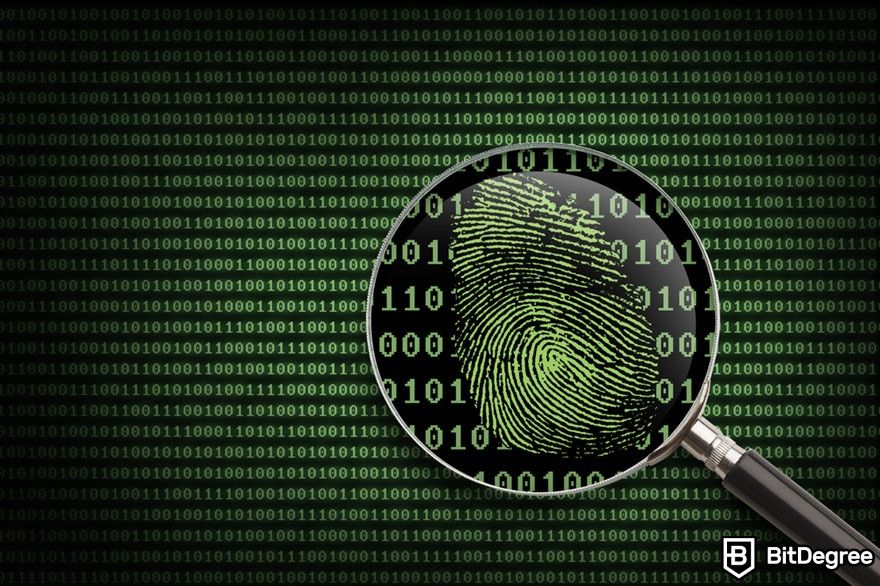
This decentralized identity platform is built on Ethereum and enables individuals to create and manage their digital identities. These identities are fully owned and controlled by the creator and don't rely on centralized third parties for creation or validation.
With Serto, education platforms can let users control their personal data and securely authenticate their identities for various educational purposes, such as verifying enrollment and exchanging academic records.
edX, a leading online learning tool, also explores blockchain for education in the platform. Their verifiable digital credentials enable learners to control and share records of their accomplishments in a way that is tamper-evident, privacy-preserving, and independently verifiable.
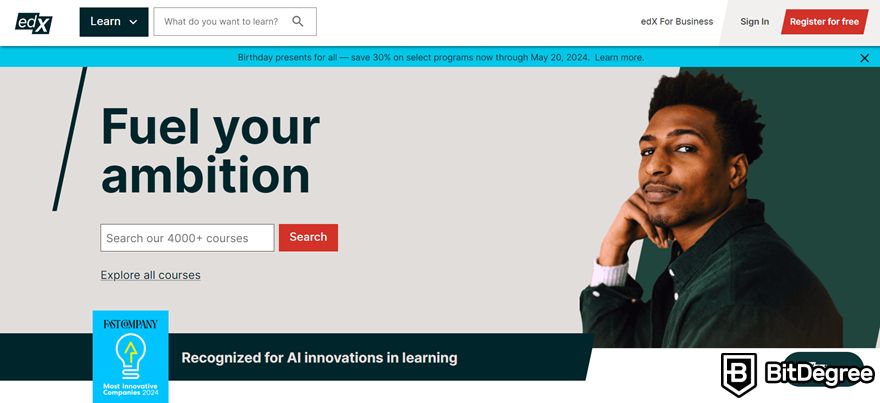
The main goal is that edX users can instantly show proof of their accomplishments to potential employers, admissions offices, or government agencies.
Then, the credential receiver can verify the accomplishment's validity and be confident that it hasn’t been tampered with, ensuring it truly belongs to the person presenting it. More importantly, the entire process can be completed in seconds!
Micro-Credentials
As education evolves, there's an increasing demand for micro-credentials and recognition of continuous learning.
Micro-credentials are short, focused certifications[1] designed to provide individuals with specific skills or knowledge in a particular area. They’re proof of the student's knowledge, skills, and experience that they can use to progress toward a larger credential or degree.
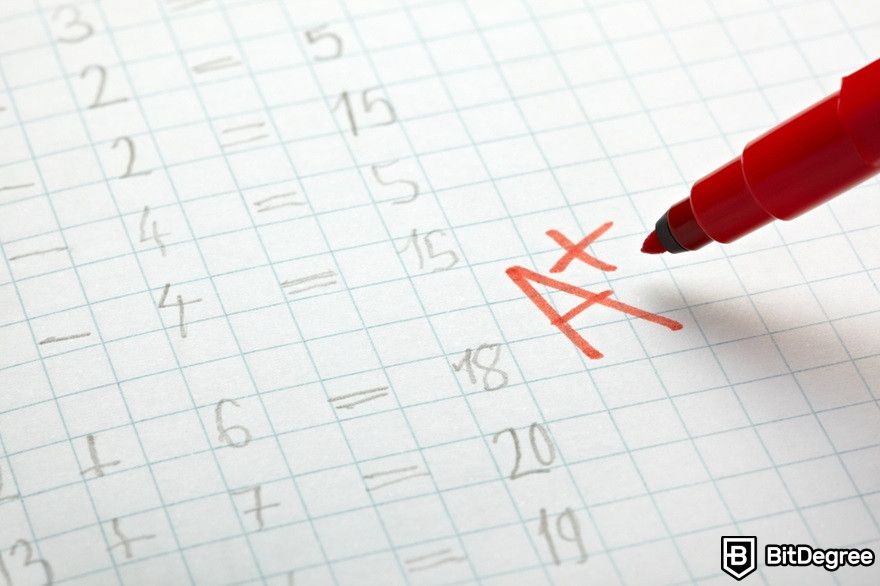
However, traditional systems often struggle to keep track of these smaller, incremental achievements.
Blockchains can store micro-credentials and achievements in a transparent, verifiable way. Students can earn digital badges or certificates for specific skills or courses, which can be easily checked by employers or other institutions.
BitDegree is an excellent example of this practice.

The platform provides both free and paid courses on subjects such as cryptocurrencies and blockchain technology.
BitDegree also encouraged learning by awarding tokenized scholarships for completing courses or achieving specific milestones.
Personalized and Lifelong Learning
Personalized learning needs trust in the validity and authenticity of learning outcomes.

A blockchain education solution provides a transparent and tamper-proof system for verifying personalized achievements.
It builds confidence among learners, educators, and employers, promoting a more flexible and trustworthy approach to education. Blockchain technology, through smart contracts, can also design learning experiences to address each student's strengths and areas for improvement.
Based on a student’s performance and preferences, smart contracts can modify course content, suggest additional resources, or adjust assessment methods in real time.
As students move through different stages of their education and careers, blockchain’s interoperability can help maintain a continuous and personalized record of their achievements and learning needs. This supports lifelong learning by allowing learners to continue their education anywhere, anytime.
For example, Disciplina uses blockchain technology to create a consolidated database of academic accomplishments and credentials for universities.

Employing a decentralized algorithm, the company automatically assesses individuals' achievements and qualifications and assigns them a score. Universities can use these scores to make personalized learning paths according to each student's needs.
Another example is ODEM, a decentralized platform that uses blockchain technology to connect educators, students, and professionals with educational products and services.

Through smart contracts, a blockchain education system in ODEM helps professors and students mutually select courses that improve students’ skills. The ODEM ledger then records each course completed by students and taught by professors.
Benefits of Blockchain Education Projects for Stakeholders
In this section, let's explore the benefits that blockchain education projects offer to each relevant party, from students to employers and the government.
Benefits for Students
For students, the integration of blockchain in education offers various benefits that enhance their learning experience and security.

Let’s take a look at each advantage in detail:
- Ownership and control of educational records. Blockchain enables students to own and control their educational records, including diplomas, transcripts, and certificates. This allows them to share their credentials easily[2] with employers, universities, or professional organizations.
- Reduced risk of academic fraud. Blockchain's immutability and cryptographic methods minimize the risk of academic fraud, ensuring that students maintain good academic integrity.
- Lifelong learning opportunities. Blockchain tech supports the creation of digital identities, enabling students to maintain a lifelong record of their educational achievements, including micro-credentials and digital badges.
- Simplified transfer and recognition. With blockchain technology, students can transfer their credentials between institutions or across borders without lengthy verification processes. This helps academic qualifications get international recognition easily.
These benefits collectively contribute to a safer, more efficient, and student-centered approach to education. Blockchain technology improves the integrity of academic records, ensures privacy and data security, and facilitates personalized learning experiences.
Benefits for Educational Institutions
In the world of education, blockchain tech offers a robust solution that promotes sustainable and transparent practices, helping institutions meet the changing needs of students and stakeholders.

Here's how blockchain education solutions can benefit academic institutions:
- Enhanced data security. Blockchain's decentralized structure reduces the risk of data breaches and unauthorized access, providing educational institutions with a more secure way to store and manage academic records.
- Streamlined administrative processes. Blockchain technology can automate and simplify administrative tasks, such as transcript verification, reducing the burden on staff and lowering operational costs in the long run.
- Improved trust and transparency. With blockchain tech, institutions can provide a transparent and tamper-proof system for issuing and verifying academic credentials, enhancing their reputation and trustworthiness.
- Collaboration and partnerships. Blockchains enable easier collaboration and data sharing among educational institutions and relevant parties, strengthening partnerships and joint programs.
These benefits show how integrating blockchain in education can revolutionize the academic environment, making institutions more secure, efficient, and interconnected.
Benefits for Employers
Besides students and academic institutions, employers can also experience numerous advantages of implementing blockchain for education.

The benefits include:
- Quick verification of credentials. Blockchain technology allows employers to verify academic credentials quickly, speeding up the hiring process for candidates with fraudulent qualifications efficiently.
- Increased trust in employee skills. With blockchain's secure and immutable records, employers can have greater confidence in the qualifications of their potential employees, leading to better hiring decisions and employee placement.
- Reduced administrative costs. Blockchain-based verification can reduce the administrative costs associated with traditional methods of validating academic records, such as storing and printing physical documents, correcting errors, and paying staff salaries.
Overall, the integration of blockchain and education can provide a powerful solution for employers to verify credentials, optimize recruitment practices, and ultimately improve workforce quality.
Benefits for Government and Regulatory Bodies
Implementing blockchain for education presents a promising solution to address various challenges faced by governments.

Let's delve deeper into the ways this technology is reshaping the academic space for the better:
- Enhanced tracking and reporting. Blockchain tech enables better tracking of educational outcomes and data, allowing governments to make more informed policy decisions and monitor the education sector's progress.
- Fighting academic fraud and corruption. By providing a secure and verifiable system for issuing academic credentials, blockchains help combat academic fraud and corruption. This can promote a fair and reliable educational environment.
- Simplified data exchange. Blockchain tech can facilitate data exchange between government agencies and educational institutions, improving the efficiency of reporting and regulatory oversight.
Ultimately, the integration of blockchain and education can bring positive change and improve outcomes for governments.
Challenges and Considerations
While blockchain education innovations offer significant potential, their adoption and implementation come with various challenges and considerations.
These issues must be addressed to ensure the successful integration of blockchain in education. Here's a detailed exploration of these challenges:
Technical Complexity
Technical complexity presents a major challenge in implementing blockchain for education.

The complexity arises from several factors:
- Lack of technical expertise. The integration of blockchain and education needs specialized technical knowledge to implement and manage effectively. Many educational institutions may lack the expertise or resources needed to navigate the complexities.
- Infrastructure requirements. Implementing blockchain in education often entails major changes to existing infrastructure and systems. Educational institutions may need to invest in new hardware, software, and networking infrastructure to support blockchain applications.
- Integration with existing systems. Integrating blockchain technology with existing educational systems, such as learning management systems (LMS) or student information systems (SIS), can be challenging. Ensuring their compatibility and seamless interoperability may require careful planning and execution.
Therefore, institutions should consider investing in training and hiring experts with knowledge of blockchain technology. Collaborating with technology partners or consultants can also help navigate the technical complexities.
Cost and Resource Allocation
Although it can pay off in the long run, the initial investment in blockchain-based solutions can be costly, including technology infrastructure, development, and training. Educational institutions with limited budgets may struggle to allocate resources for blockchain projects.
Implementing blockchain-based systems also often involves integrating existing educational platforms and databases, which can be complex and costly.

If an institution decides to scale, the ongoing maintenance and operational costs associated with blockchain networks may strain budgets. These costs include network maintenance, software updates, and cybersecurity measures to ensure the security of blockchain-based educational systems.
To conquer the challenge, institutions need to consider conducting thorough cost-benefit analyses to understand the return on investment. Exploring partnerships and pilot programs can help reduce initial costs and test feasibility before full-scale implementation.

- Secure and reliable
- Accepts fiat currencies
- Lots of trading options
- Reputable exchange
- Accepts fiat currencies
- Offers various trading options

- Fiat currencies - accepted
- Simple to use
- Accepts only the most trustworthy cryptocurrencies
- A leading cryptocurrency exchange platform
- Best for beginner investors
- Accepts fiat currencies

- Fully reserved and transparent
- Multiple tradable asset classes
- Over 300 supported cryptos
- Over 300 cryptocurrencies
- Secure & transparent
- Fully reserved
Environmental Impact
Some blockchain technologies, particularly Proof-of-Work systems, have a major environmental impact due to high energy consumption. This raises concerns about sustainability.
For example, the Bitcoin mining network consumed 173.42 Terawatt hours of electricity during the 2020-2021 period. The resulting carbon footprint was similar to that of burning 84 billion pounds of coal.
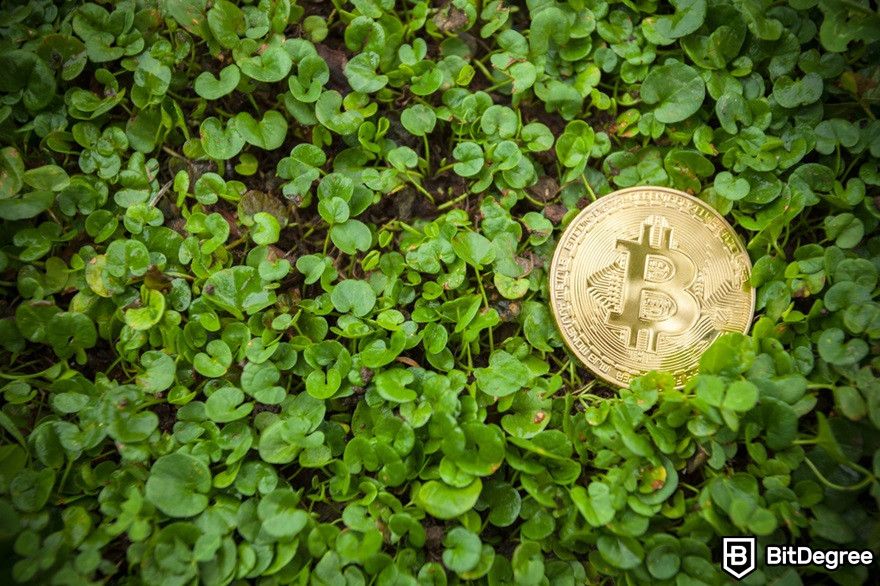
To offset this footprint, you would need to plant 3.9 billion trees, covering an area almost equal to the area of the Netherlands, or 7% of the Amazon rainforest.
Therefore, educational institutions should explore energy-efficient blockchain technologies, such as Proof-of-Stake or other consensus mechanisms with lower energy requirements. Choose green blockchain solutions that align with sustainability goals.
Conclusions
In conclusion, blockchain education solutions offer a promising opportunity for transforming traditional academic systems.
With decentralized ledger technology, these solutions can improve the security, transparency, and efficiency of managing academic systems. By providing tamper-proof records and reducing the risk of fraud, blockchain technologies ensure the integrity of academic credentials.
As we continue to explore blockchain's potential in education, the integration of crypto wallets like Binance opens up new opportunities for incentivizing student engagement and achievement through rewards and incentives, paving the way for fun and personalized learning experiences.
The content published on this website is not aimed to give any kind of financial, investment, trading, or any other form of advice. BitDegree.org does not endorse or suggest you to buy, sell or hold any kind of cryptocurrency. Before making financial investment decisions, do consult your financial advisor.
Scientific References
1. Alsobhi, H.A., Alakhtar, R.A., Ubaid, A., et al.: ‘Blockchain-based micro-credentialing system in higher education institutions: Systematic literature review’;
2. Koshiry, A.E., Eliwa, E., El-Hafeez, T.A., et al.: ‘Unlocking the power of blockchain in education: An overview of innovations and outcomes’.

